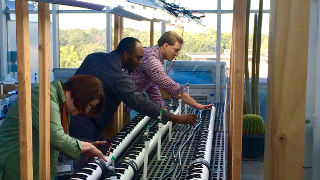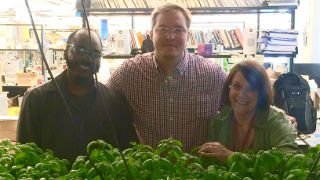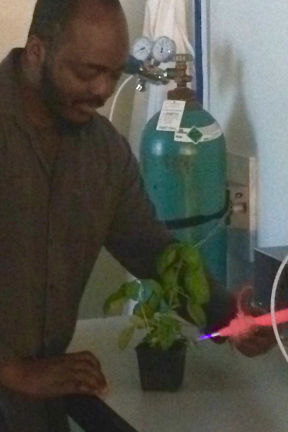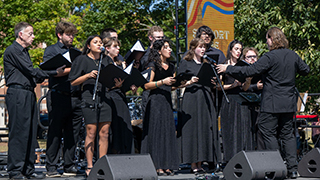Graduate Student Receives Grant from NASA to Study Effects of Cold Plasma on Plant Growth - Seton Hall University
Wednesday, October 18, 2017

The combination of disciplines— physics, chemistry and biology— allows the researchers to combine their expertise to more comprehensively study the impact of cold plasma on plant life.
This research is not merely theoretical exercise, as the researchers are in pursuit of answers regarding a cutting-edge process that may well have a profound effect on the world's food supply.
"I'm honored that NASA has funded this study here at Seton Hall," said Daniel Piatek. "Although new, the implications of the research on the effect of cold plasma plant growth stimulation to date are truly promising."
Previous studies have shown that the use of an atmospheric pressure plasma jet on plants can accelerate the growth rate of the plant and increase its overall size and yield. Additionally, before the plants even start their growth cycle, these atmospheric plasma jets can be utilized to help promote the germination of plant seeds.
Seton Hall is one of only a handful of Universities across the globe studying the effects of cold plasma distributed upon the body of plants— though the practice has quickly come to be thought by many to be a scientific breakthrough with potentially major implications for feeding the world.
"This work, for me, is the culmination of a lifetime devoted to science and learning," said Professor Mary Berger. "I was one of the first co-eds here at Seton Hall studying science as a student, and now I find myself mentoring students in the lab and functioning as a 'biology liaison' in the midst of truly important work."
Although the preliminary studies have shown promising results for the implementation of these plasma jets as a non-GMO tool for plant growth, the mechanism by which they act is yet to be determined. To that end, the studies will examine the effects of cold plasma treatment upon the plants' biochemical pathways— which are akin to the neural pathways in human beings, and function as the conduits for growth, adaptation and systemic regulation.
Piatek's study, undertaken under the advisement of Physics Professor Jose Lopez, is focused on understanding how and why these atmospheric or cold plasma jets effect the plant growth cycles in kidney beans. Auguste's study, under the advisement of Fr. Gerald Buonapane of the Chemistry department, is focused on sweet basil.

Plants require certain external conditions to survive and thrive. These physical conditions
can have a significant impact on their growth and development and can either impede
or accelerate it. Simply put, environment is key to growth.
Some important environmental factors include: proper exposure to sunlight, the requisite supply of water and specific nutrients at specific concentrations.
But even when all these environmental factors are met, there are still various external stressors that affect the plant at various stages in its life cycle which may alter its physical properties and effect its overall ability to flourish.
These external stressors may be viewed as either negative or positive. Some life forms are unable to adjust to a stressor and ultimately perish. Throughout history, however, natural stressors have been the driving factor behind biological evolution. When an organism can adapt to these stressors in a positive way, it may live on to proliferate, stronger in some ways for the challenge it has met.
Understanding how these stressors effect the plant is of key significance though because it affords the opportunity to introduce synthetic stressors which may accelerate growth or bring out key desirable characteristics.
Although surrounded by scientific terms and descriptors, you can think of this all, in a sense, as "the culture" in agriculture— a process ongoing since man first planted seeds and reaped a harvest and then immediately set about trying to improve that harvest. Whether we talk about the use of fertilizer, irrigation, plows, plant grafting, crop rotation, hybridization or any other number of agricultural innovations over the millennia, we are ultimately talking about introducing new tools and methodologies to better farm and feed.
Which brings us to the atmospheric pressure plasma jet— which appears to be a positive stressor when synthetically introduced into a plant's environment.
Atmospheric Pressure Plasma Jet
Atmospheric pressure plasma jets, or "APPJs" are created by applying a high voltage
electrical current across a gap containing high velocity gas flow, in this instance,
helium. The plasma that is formed is then pushed out of the gas gap and the plasma
effluent can be used as a tool to treat the plant surfaces – with a variety of different
effects.
As noted above, previous studies have shown that the use of these atmospheric plasma jets on plants can accelerate the growth rate of the plant as well as increase the overall size and yield.
Piatek's work follows and builds upon an interdisciplinary research project at Seton Hall which was presented as part of the Rose Mercadante Chemistry Seminar series in the winter of 2017 by Fr. Gerald Buonopane, Professor Cosimo Antonacci and Professor Jose Lopez of the Departments of Chemistry and Biochemistry and Physics of Seton Hall University. Their presentation, "Effect of Cold Plasma Processing on Sweet Basil and the Chemistry of its Essential Oils," described their use of these atmospheric plasma jets to stimulate the growth of sweet basil.
This research could have a marked impact on our food supply, not only improving crop yields significantly, but also enabling food that is subject to spoiling to be preserved—with the natural by-products which result from plasma treatment replacing synthetic preservatives and antioxidants that have been shown to be potentially harmful to human health.
As noted at the time of the Rose Mercadante Seminar by the Seton Hall scientists:
This interdisciplinary research project, which focuses on the emerging field of plasma agriculture, seeks to better understand the chemical and physical effects of cold plasma processing on plants and their essential oils. Cold plasma processing has been shown to be a rapid, economical, and pollution-free method to improve plant seed performance and crop yield.
Essential oils are aromatic oily liquids extracted from different parts of plants, such as the leaves, flowers, and roots. Among the various beneficial properties of essential oils is their demonstrated antioxidant effect directly applicable to foods that are prone to oxidative consequences such as poor flavor, bad odors, and spoilage. Antioxidants, either synthetic (e.g., butylated hydroxytoluene, BHT) or natural (e.g., Vitamin C), are routinely added to processed foods to inhibit or delay oxidation. Essential oils are examples of natural antioxidants. Although synthetic antioxidants like BHT and BHA (butylated hydroxyanisole) are very effective, they have been shown to be potentially harmful to human health with demonstrated evidence of causing cancer in laboratory animals. As a result, food scientists have been seeking alternative natural compounds as substitute antioxidants, such as essential oils.
We have observed a growth effect in our preliminary studies treating basil plants with cold plasmas. We have also observed that plasma treatment increases the antioxidant activity of essential oils. Our preliminary work further revealed a difference in the composition of individual antioxidant components between the plasma-treated and non-plasma-treated basil. In follow-up studies, we seek to better understand cold plasma's physical and biochemical-molecular effects on basil plants.
Piatek's work, funded by NASA, is one of those follow-up studies, as is Auguste's.
The Experiment

Piatek's study tests the effects of the application of atmospheric plasma jets for various treatment durations, application frequencies, and plasma energies on red kidney beans, which are part of the Order of Fabales plants. The kidney beans are to be grown hydroponically under controlled conditions including: humidity, watering, feeding, and artificial light.
Auguste's study focuses solely upon sweet basil, also a member of the Order of Fabales and does not utilize hydroponics.
The tests for both studies include seed treatment, root treatment, and intermittent treatments of the leaves during the vegetative, budding, and flowering stages. The treated plants are then compared to their untreated counterparts by method of visual assessment of height and volume via time lapsed photography.
Additionally, a sample set is periodically sacrificed for quantitative analysis to measure internal metabolic functions, or "content," so to speak. Once the plants reach maturity, the foliage and any fruits produced are collected and processed for essential oil extraction which are then analyzed for chemical makeup, concentration and purity.
Next Steps
Piatek and a number of other students are finishing up the final touches on a hydroponic
system in the greenhouse on top of McNulty Hall to stage the study and hope to have
a full slate of results in the near future. After the results are in, Piatek's research
will be the subject of a paper and a poster presentation.
Auguste's research is further along, and he hopes to be able to present results soon. Born in Haiti, Auguste tries to put the work in perspective: "Growing up in Haiti, I know what a shortage of food looks like — and I also know that I want to do everything in my power to help put a stop to it."






